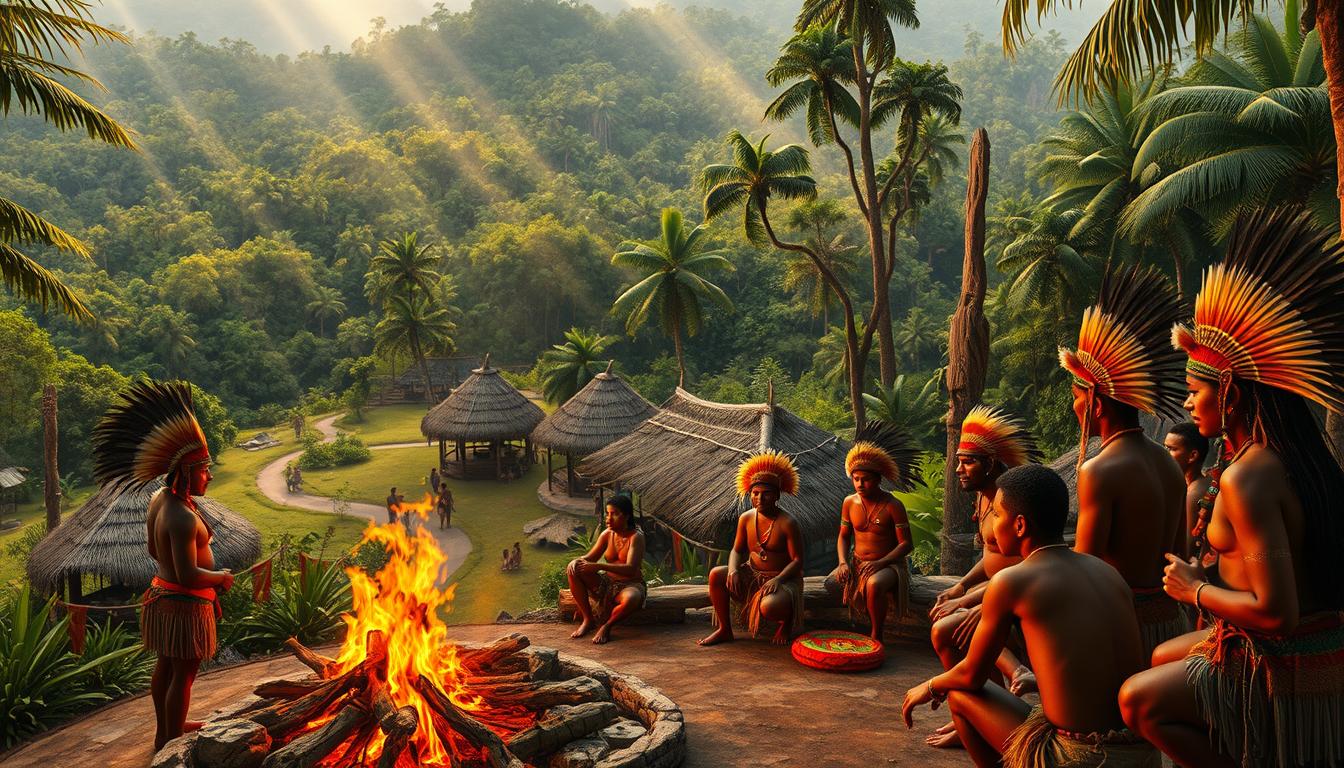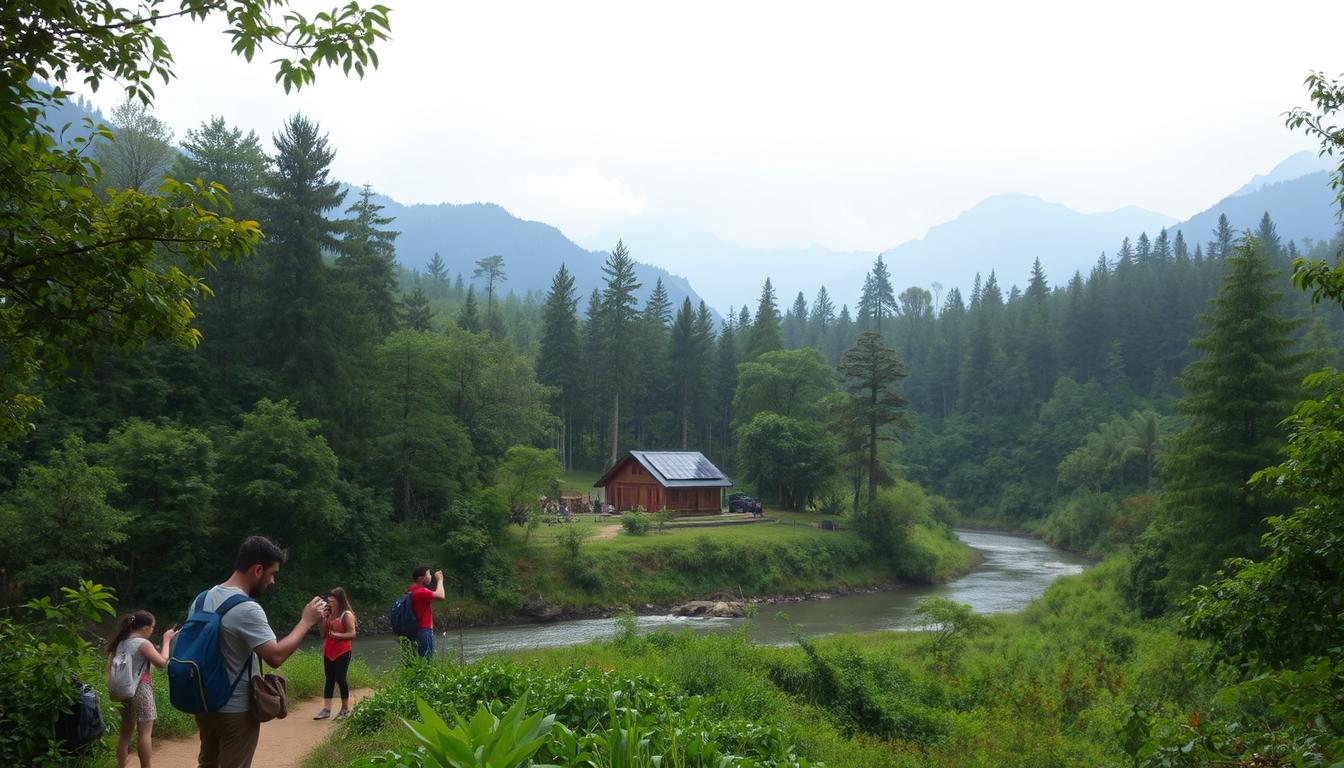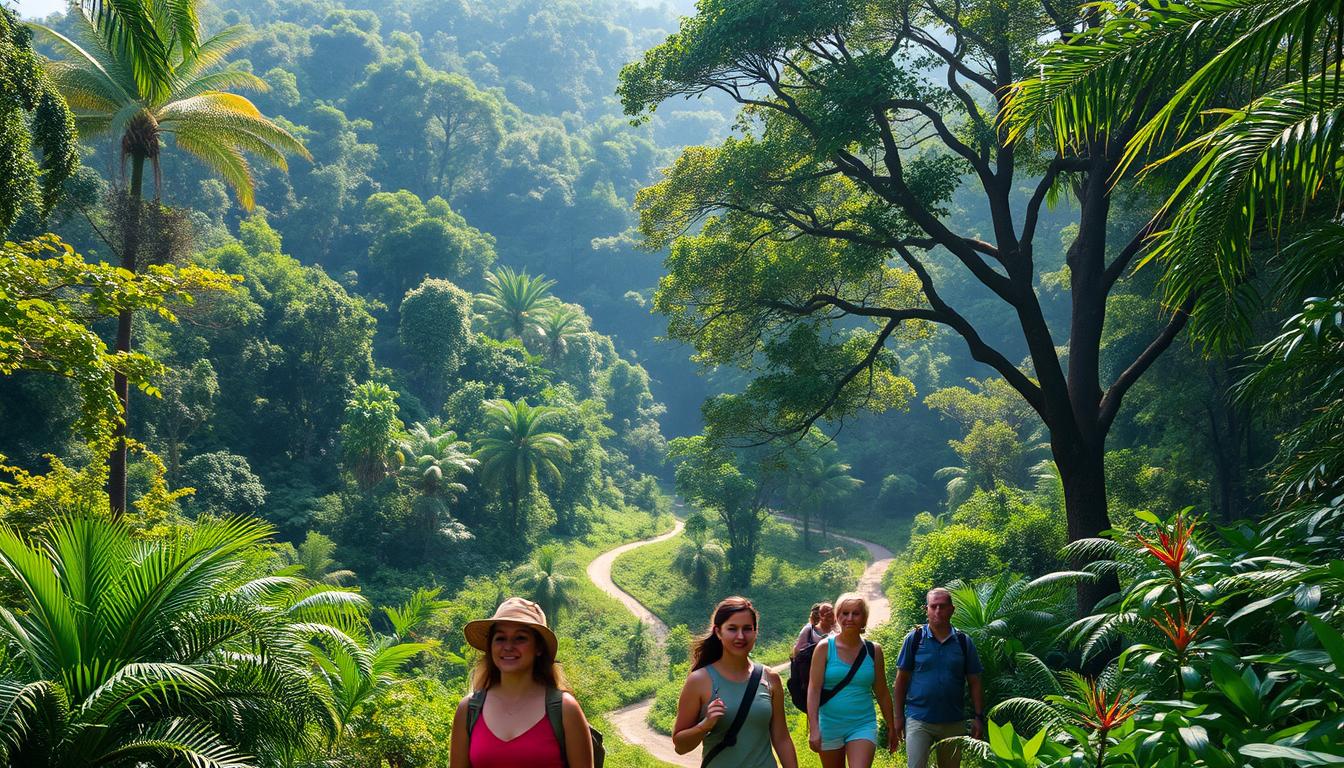Deep within Amazon jungle, a world of vibrant cultures and traditions awaits. For centuries, indigenous tribes have thrived in this lush ecosystem, developing rich social and cultural content that is as diverse as it is fascinating.
As we journey through the heart of the Amazon rainforest, we discover the unique cultural heritage of its inhabitants. From ancient rituals to modern-day customs, the Amazon rainforest culture is a testament to the resilience and adaptability of its people.
Key Takeaways
- The Amazon jungle is home to a diverse array of indigenous cultures.
- The social and cultural content of the Amazon jungle is rich and varied.
- The Amazon rainforest culture has been shaped by centuries of history and tradition.
- Preserving the cultural heritage of the Amazon jungle is crucial for future generations.
- The Amazon jungle’s unique cultural tapestry is a valuable resource for cultural exchange and understanding.
The Rich Cultural Mosaic of the Amazon Rainforest
The Amazon rainforest is a melting pot of cultures, with over 400 indigenous groups living in harmony with the lush environment. This rich cultural diversity is a result of centuries of history, geography, and social interactions.

Geographic Distribution of Cultural Groups
The Amazon rainforest spans across nine countries in South America, with different indigenous groups inhabiting various regions. The geographic distribution of these cultural groups is influenced by factors such as river access, soil quality, and climate.
Historical Development of Amazonian Societies
Amazonian societies have developed complex trade networks, cultural exchange systems, and social interactions over centuries. The historical development of these societies has been shaped by their environment, with many groups developing sophisticated agricultural practices and forest management techniques.
Cultural Diversity Statistics and Overview
The Amazon rainforest is home to an estimated 400-500 indigenous groups, speaking over 300 languages. The cultural diversity of the region is staggering, with many groups maintaining their traditional practices, customs, and beliefs. Statistics on cultural diversity in the Amazon reveal a rich tapestry of cultures, highlighting the importance of preserving this cultural heritage.
| Indigenous Group | Population | Language |
|---|---|---|
| Ticuna | 40,000 | Ticuna |
| Yanomami | 35,000 | Yanomami |
| Asháninka | 60,000 | Asháninka |
Indigenous Tribes: The Heart of Amazonian Society
At the heart of the Amazon rainforest lies a vibrant tapestry of indigenous tribes, living in harmony with the natural environment. These communities have thrived for centuries, developing complex social structures, rich cultural practices, and a deep understanding of the rainforest ecosystem.

Major Tribal Groups and Their Territories
The Amazon is home to numerous indigenous tribes, with some of the major groups including the Ticuna, Yanomami, and Ashaninka. These tribes inhabit vast territories within the Amazon rainforest, with some communities located in remote areas that are difficult to access. The Ticuna, for example, are the largest indigenous group in the Amazon, with a population of over 40,000 spread across Brazil, Colombia, and Peru.
Each of these tribal groups has its own distinct culture, language, and traditions. They have developed sophisticated systems for managing the rainforest environment, including practices for hunting, gathering, and agriculture that ensure the long-term sustainability of the ecosystem.
Language Diversity and Communication Systems
One of the hallmarks of Amazonian indigenous cultures is their incredible language diversity. With hundreds of languages spoken across the region, the Amazon is one of the most linguistically diverse places on Earth. Many of these languages are considered endangered, as younger generations increasingly adopt more widely spoken languages like Portuguese or Spanish.
Indigenous communities have developed complex communication systems, both within their own languages and between different linguistic groups. These systems often involve a combination of verbal and non-verbal communication, including storytelling, ritual, and art.
Social Organization Within Tribal Communities
Indigenous tribes in the Amazon are organized into complex societies, with systems of governance, kinship, and social hierarchy. Many communities are organized around kinship ties, with family relationships playing a crucial role in determining social roles and responsibilities.
Decision-making processes within these communities often involve consensus-building and collective discussion, ensuring that all members have a voice in important decisions.
Contemporary Challenges and Resilience
Despite their rich cultural heritage and deep connection to the land, indigenous tribes in the Amazon face numerous contemporary challenges. These include deforestation, climate change, and encroachment by external actors such as loggers and miners.
Despite these challenges, indigenous communities have shown remarkable resilience, adapting to changing circumstances while maintaining their cultural identities. Efforts to support indigenous rights and protect the Amazon rainforest are crucial to ensuring the long-term survival of these communities.
The Social and Cultural Content of the Amazon Jungle
The Amazon jungle’s indigenous populations have a distinct social and cultural identity shaped by their history, traditions, and interactions with the environment. This identity is reflected in their community governance, family structures, gender roles, and cultural adaptation practices.

Community Governance and Decision-Making Processes
Community governance in the Amazon jungle is often characterized by traditional leadership structures, such as councils of elders. These councils make decisions that benefit the community as a whole, taking into account the needs and perspectives of all members.
Decision-making processes vary across different indigenous groups, but often involve consensus-building and collective discussion. This approach ensures that everyone is in agreement with the decisions made, promoting social cohesion and cooperation.
| Community | Governance Structure | Decision-Making Process |
|---|---|---|
| Ticuna | Council of Elders | Consensus-building |
| Yanomami | Village Headman | Collective Discussion |
| Asháninka | Traditional Leaders | Consensus-based |
Family Structures and Kinship Systems
Family structures in the Amazon jungle are often extended and complex, with multiple generations living together. Kinship systems play a crucial role in determining social relationships and responsibilities within the community.
In some indigenous groups, kinship is determined through matrilineal or patrilineal lines, influencing inheritance, social status, and family obligations. Understanding these kinship systems is essential for grasping the social dynamics of Amazonian communities.
Gender Roles and Social Dynamics
Gender roles in the Amazon jungle vary across different cultures, with some societies exhibiting a high degree of gender equality. In others, traditional roles are more pronounced, with men and women having distinct responsibilities and expectations.
Social dynamics are influenced by a range of factors, including family structures, kinship systems, and cultural traditions. Understanding these dynamics is crucial for appreciating the complexity of Amazonian societies.
Cultural Adaptation and Modernization
As the Amazon jungle becomes increasingly integrated into the global economy, indigenous communities are facing new challenges and opportunities. Cultural adaptation and modernization are becoming more prevalent, with many communities adopting new technologies and practices while maintaining their traditional ways of life.
This blending of traditional and modern practices is resulting in the creation of new cultural forms and expressions, as well as new challenges and opportunities for Amazonian communities.
Traditional Practices and Spiritual Beliefs
Traditional practices and spiritual beliefs are integral to the identity of Amazonian societies, reflecting their deep connection with nature. These practices not only define the cultural fabric of the communities but also play a crucial role in their daily lives and interactions with the environment.
Shamanism and Traditional Medicine
Shamanism is a cornerstone of spiritual practice in many Amazonian communities. Shamans are revered for their ability to communicate with the spirit world, heal ailments, and provide guidance. Traditional medicine, based on the knowledge of local flora and fauna, is used to treat a variety of health issues, from physical injuries to spiritual afflictions.
Ayahuasca, a plant-based brew, is a key component in many shamanic rituals, believed to facilitate spiritual healing and insight.

Ceremonial Rituals and Life Cycle Celebrations
Ceremonial rituals mark important life events and transitions within Amazonian communities, such as births, coming of age, marriages, and deaths. These ceremonies are often rich in symbolism and involve the entire community, reinforcing social bonds and cultural identity.
“The rituals we perform are not just celebrations; they are a way of communicating with our ancestors and the natural world.”
Mythology and Folklore of the Amazon
The mythology and folklore of the Amazon are rich with stories of creation, supernatural beings, and the origins of natural phenomena. These stories are passed down through generations, serving as a means of cultural preservation and education.
- Stories of the Yacumama, or “water mother,” a serpent-like spirit believed to inhabit the rivers.
- Tales of the Kurupira, a mischievous spirit known for guarding the forest.
Environmental Stewardship and Spiritual Connection to Nature
Many Amazonian communities have a profound spiritual connection to the natural world, viewing themselves as part of the ecosystem rather than separate from it. This perspective fosters a deep commitment to environmental stewardship, with practices aimed at preserving the rainforest and its inhabitants.
| Practice | Description | Benefit |
|---|---|---|
| Rotating Crops | Alternating crops to avoid depleting soil nutrients. | Maintains soil fertility. |
| Forest Gardening | Cultivating useful plants within the forest. | Enhances biodiversity. |
| Ritual Hunting | Hunting practices governed by spiritual beliefs. | Conserves wildlife populations. |
The traditional practices and spiritual beliefs of the Amazon Jungle are a testament to the rich cultural diversity and resilience of its indigenous communities. Understanding and respecting these practices is crucial for supporting their continued well-being and the preservation of the Amazon rainforest.
Artistic and Culinary Expressions
The Amazon is home to a kaleidoscope of artistic and culinary expressions, deeply rooted in the history and daily life of its native populations. This rich cultural heritage is evident in various aspects of Amazonian life, from traditional music and dance to intricate crafts and unique culinary practices.

Music, Dance, and Oral Traditions
Music and dance are integral parts of Amazonian cultural identity, with each tribe having its unique rhythms and dances. These oral traditions are passed down through generations, often telling stories of ancestral heritage and mythological beliefs. For instance, the Ticuna people are known for their vibrant dances, which are performed during various ceremonies.
- Ritual dances are performed during initiation ceremonies and other significant life events.
- Traditional instruments, such as flutes and drums, play a crucial role in Amazonian music.
- Oral storytelling is a cherished tradition, preserving the history and myths of the community.
Visual Arts and Craftsmanship
The visual arts in the Amazon are characterized by intricate craftsmanship, including basket weaving, pottery, and wood carvings. These crafts are not only aesthetically pleasing but also carry significant cultural meaning. The Shipibo people are renowned for their elaborate ceramic designs, which often depict mythological creatures and natural motifs.
- Intricate patterns and designs are used in traditional clothing and artifacts.
- Craftsmanship is passed down through generations, with techniques refined over time.
- Amazonian crafts are highly valued for their uniqueness and cultural significance.
Traditional Cuisine and Food Gathering Practices
Traditional Amazonian cuisine is deeply connected to the forest environment, with a diet rich in fish, fruits, and forest plants. Food gathering practices are sustainable, ensuring the preservation of the ecosystem. The Asháninka people, for example, have a diverse diet that includes a variety of forest fruits and fish from the rivers.
- Food gathering is a communal activity, often involving the whole family.
- Traditional cooking methods include grilling and boiling, using locally sourced ingredients.
- The Amazonian diet is not only nutritious but also reflects a deep understanding of the natural environment.
Cultural Exchange and Influence on Global Arts
As the Amazon becomes more connected to the global community, there is a growing exchange of cultural influences. Amazonian arts and traditions are influencing global arts, with elements of indigenous culture being incorporated into contemporary art forms. This exchange enriches both the local and global cultural landscapes.
- Amazonian motifs are being used in modern fashion and design.
- Indigenous music and dance are being appreciated worldwide, promoting cultural understanding.
- The global arts scene is becoming more diverse, thanks in part to Amazonian cultural influences.
Conclusion: Preserving the Amazon’s Cultural Wealth
The Amazon jungle is a treasure trove of cultural wealth, with a rich and diverse array of cultures and traditions. Preserving this cultural heritage is crucial for promoting cross-cultural understanding and supporting indigenous communities.
Efforts to protect indigenous lands and preserve traditional practices are essential to ensuring the long-term survival of Amazonian cultures. By promoting cultural exchange and safeguarding the region’s unique cultural heritage, we can help to preserve the Amazonian cultural heritage for future generations.
The cultural significance of the Amazon jungle cannot be overstated, and it is our responsibility to preserve this precious cultural wealth. By working together, we can ensure that the Amazon’s cultural heritage continues to thrive and inspire future generations.




